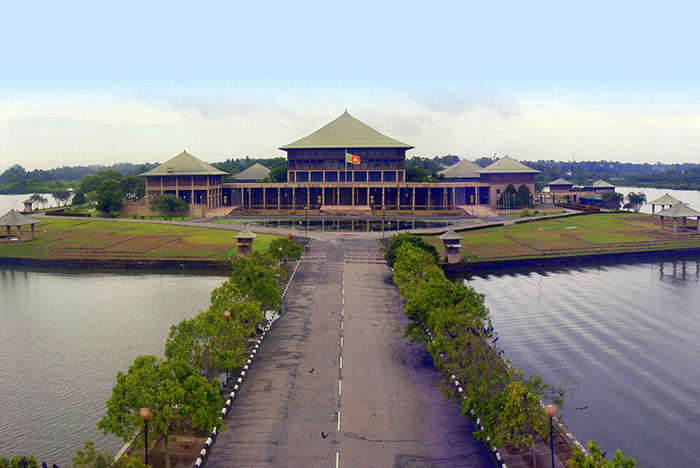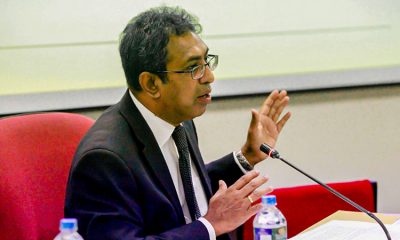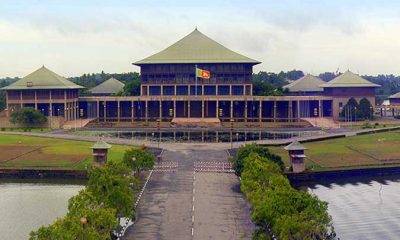Features
A departure from the 1995 Age of Consent Legislation

Examining Sri Lanka’s New ‘Romeo and Juliet Law’:
By Prof. M.W. Amarasiri de Silva
According to an article published in The Island newspaper on March 25, 2024, Dr. Sudarshini Fernandopulle, MP, has raised concerns about the lack of consultation with the Women Parliamentarians’ Caucus before the Justice Ministry gazetted a bill on February 9, 2024. This bill aimed to amend Chapter 19 of the Penal Code, proposing a reduction in the age of consent for sexual intercourse to 14 years. Dr. Fernandopulle emphasised that this provision directly relates to the human rights of children, with a specific focus on girls. She highlighted the profound impact such legislation could have on their lives, including implications for health and individual identity. Therefore, she stressed the importance of a cautious and sensitive approach to safeguard children’s rights and well-being.
In light of this discussion, I wish to present the findings of a study I conducted for UNICEF in 2009, demonstrating how increasing the age of marriage to 16 years has significantly reduced instances of underage sexual activities such as rape and non-consensual sex. This research underscores the critical need for comprehensive measures to protect children, particularly in matters as crucial as the age of consent.
The General Marriage Ordinance of 1907 and the Kandyan Marriage and Divorce Act of 1952 permitted child marriages. Notably, most marriages in Sri Lanka were registered, including those of children before 1995. In 1995, significant amendments were made to both these laws, effectively removing the legal sanction for marriages under 18. The legal age of marriage was raised to 18 years. Notably, the law was interpreted to disallow parental consent for marriages of children under 18 years, establishing an absolute prohibition. These legal changes also impacted the Penal Code, raising the age of sexual consent from 12 to 16 years. This adjustment in the Penal Code has direct implications for the law on rape.
The concept of “statutory rape” in criminal law, which pertains to sexual intercourse with a minor below the age of 16, became legally recognized. It’s worth noting that these legal reforms did not affect the Muslim community, as their marriage system operates under the jurisdiction of Muslim law. While the Muslim Law Research Committee proposed raising the age of marriage within the Muslim community, this recommendation has yet to be implemented. However, within the Muslim community, the existing criminal law prohibits sexual intercourse with a child wife under 12 years of age. This provision is interpreted as a form of statutory marital rape, illustrating the complexities within the legal framework concerning marriage and sexual consent across different communities in Sri Lanka.
Early Child Marriages
Early (child) marriages, defined as those occurring before the age of 18, and instances of statutory rape involving individuals under 16 years of age, disproportionately affect young girls. When a case of child marriage is reported, the male partner often faces legal consequences. In many instances, he is sentenced to rigorous imprisonment, ranging from a minimum of 10 years to a maximum of 20 years.
Court decisions frequently direct the girls involved in such marriages to correctional institutes like the Girl’s Home in Ranmuthugala. They undergo a reform and rehabilitation program typically lasting three years or less. After completing the program, they are returned home under the supervision of the Probation Officer from the respective Probation Division. This process aims to support and guide the girls as they reintegrate into society after their challenging experiences.
In cases of statutory rape, the girl in question undergoes examination by the respective Judicial Medical Officer (JMO), who then initiates a correctional program tailored to the girl’s needs. Additionally, the JMO provides crucial evidence for legal action against the perpetrators. According to the Penal Code, any instance of vaginal intercourse with a girl under 16 years old, regardless of whether it occurred within the context of a consensual marriage, romantic relationship, or otherwise, constitutes rape. Perpetrators are thereby subject to prosecution and may face rigorous imprisonment, with a minimum sentence of ten years and a maximum of 20 years.
A 2009 study revealed a significant decrease in registered marriages involving individuals under 18 years old in Sri Lanka between 1994 and 2003. This decline has been particularly pronounced following the amendment of marriage laws in 1995, which raised the legal age of marriage to 18 years. The data indicates a substantial drop from approximately 6,000 male and female individuals marrying before turning 18 in 1996 to only around 1,000 in 2003. This decline can be attributed to the legislative changes implemented in 1995 and is evident across all ethnic groups except the Muslim community.
Concerning Trend
The evidence presented in this report indicates a concerning upward trend in the incidence of early marriages and statutory rape. There are indications that these practices are on the rise, particularly in less developed districts and Divisional Secretariat divisions, areas affected by conflict, specific ethnic communities, the estate sector, and impoverished regions. Data from various agencies, including safe houses and Certified Schools for female children, suggests that the percentage of girls entering these institutions who have experienced statutory rape and consensual marriages is increasing. It’s crucial for lawmakers to consider the full spectrum of implications when drafting new legislation, especially when it concerns sensitive issues like the age of consent.
While reducing court cases of underage sex and rape may be an intended outcome of such a law, it’s equally important to weigh the potential social, psychological, and physiological consequences.
Here are some key considerations that lawmakers should take into account:
1. Social Implications: Lowering the age of consent may shift societal norms and attitudes toward sexual behaviour among adolescents. This could lead to changes in how young people perceive relationships, intimacy, and consent, potentially influencing their behaviour in ways that may not align with their emotional or cognitive maturity.
2. Psychological Implications: Adolescents may face increased pressure to engage in sexual activities before they are emotionally or mentally ready, leading to negative psychological consequences such as trauma, regret, or confusion. Additionally, lowering the age of consent may blur boundaries between age groups, potentially exposing younger individuals to situations they are ill-prepared to handle.
3. Physiological Implications: Adolescents undergo significant physical and hormonal changes during puberty, but these changes do not necessarily correspond to the development of emotional or cognitive maturity. Lowering the age of consent without considering these differences could increase the risk of exploitation or harm to individuals who are not fully equipped to make informed decisions about their sexual health.
4. Legal Safeguards: While reducing court cases related to underage sex and rape is a valid concern, it’s important to ensure that legal safeguards are in place to protect individuals from coercion, manipulation, or abuse. This includes robust education on consent, comprehensive sex education programs, and adequate support systems for victims of sexual violence.
UN Convention
Overall, any proposed changes to the age of consent should be accompanied by thorough research, consultation with experts in fields such as psychology, sociology, and public health, and a comprehensive understanding of the potential consequences for individuals and society as a whole. Balancing legal objectives with ethical considerations is essential in crafting legislation that promotes the well-being and safety of all individuals, particularly vulnerable populations such as adolescents.
The United Nations Convention on the Rights of the Child defines a child as any individual below the age of 18 years. Consequently, any form of sexual activity involving those under 18 years old can logically be categorized as child abuse or rape. The legal age of consent for engaging in sexual intercourse varies from one country to another. In the United States, it ranges from 16 to 18 years of age, with California setting it at 18 years.
In India, the age of consent is established at 18 years according to the Protection of Children from Sexual Offences (POCSO) Act. Before the enactment of the POCSO Act in 2012, there was no distinct age of consent defined for males, and it was determined by Section 375 of the Indian Penal Code, which outlines the definition of “rape.” The Law Commission of India advised against altering the age of consent from 18 years, noting that this age has fluctuated significantly in Indian legal history.
Initially set at ten years in 1860, it was raised to 16 years for females until 2012. The decision to increase the age of consent for females in India was informed by tragic events such as the Phulmoni case. In 1860, the age of consent for females was a mere ten years. However, following public outrage sparked by the Phulmoni case in 1891, where an 11-year-old girl died due to injuries sustained during forced sexual intercourse by her husband, the age of consent for women was raised to 12 years under Section 375. Despite the severity of the crime, the husband was convicted only of causing grievous hurt by a rash or negligent act endangering life, and he received a sentence of one year’s rigorous imprisonment. Thereafter, the age of consent was raised to 14 years in 1925 and to 16 years in 1940.
Enactment of POCSO
Before the enactment of the Protection of Children from Sexual Offences (POCSO) Act in 2012, the age of consent for females in India stood at 16 years, while there was no specific age of consent defined for males. Over time, amendments to the marital rape exception outlined in Section 375 of the law have occurred. This exception has evolved from setting the age at ten years in 1860 to 15 years by 2012.
Sri Lanka is considering lowering the age of consent for sexual intercourse to 14 years. This proposed statutory change raises concerns about potential significant negative consequences. While there has been some debate on the matter, it is widely acknowledged that establishing a minimum age limit for sexual consent is crucial. It is essential to recognize that children under the age of 14 lack both the cognitive development and emotional maturity necessary to make informed decisions about their sexual behaviour.
Lowering the legal age of sexual consent would result in the decriminalisation of a significant number of underage individuals engaging in sexual intercourse. The arguments against such a legal amendment are summarized and demonstrated to lack validity. This proposal is not merely contrary to popular opinion but is widely viewed as absurd. In 2013, when Professor John Ashton, then President of the Faculty of Public Health, Royal Colleges of Physicians, Liverpool, England, suggested reducing the age of consent from 16 years to 15 or 14 years, the proposal was promptly rejected by representatives from both the government and the opposition. Even Prime Minister David Cameron referred to the suggestion as “offensive.”
There are numerous compelling arguments against such a change. This proposal could have far-reaching implications for other areas where the rights of young people are unfairly restricted. Across all jurisdictions in the UK, the existing laws dictate that the age of consent for any form of sexual activity is 16 years for both males and females, regardless of their sexual orientation or the gender of their partner(s).
In the United States, engaging in sexual activity with a person under the age of 16 is considered an offense. However, Home Office guidance in the USA clarifies that there is no intention to prosecute teenagers under 16 if both parties consent and are of similar ages. Additionally, it is unlawful for an individual aged 18 or older to engage in sexual activity with a person under 18 if the older person holds a position of trust, such as a teacher or social worker, as such conduct constitutes an abuse of trust. There is no evidence to suggest that the legal minimum age of sexual consent in a country correlates with the sexual behavior of young people.
A change in the law is often argued to potentially lead to an increase in younger children engaging in inappropriate sexual activity. However, there is a notable lack of evidence supporting this claim. Much of the available evidence suggests that the current legal framework has minimal impact on the sexual behavior of young individuals. For instance, data collected between 2010 and 2012 indicates that 31% of British males and 29% of British females had experienced full sexual intercourse before reaching the age of 16. Comparatively, fifty years earlier, only 15% of males and 4% of females reported engaging in sexual intercourse before this age. Remarkably, there had been no alteration in the law concerning heterosexual intercourse during this time period. Furthermore, a study examining the reasons for sexual abstinence among American school students found that the law was not commonly cited as a factor influencing their decision to abstain from sexual activity.
Young people aged 14 years typically lack the cognitive maturity necessary to assess the risks associated with engaging in sexual activity. There is substantial evidence suggesting that 14-year-olds does not possess the cognitive capacity to evaluate risks and benefits, comparable to individuals aged 21. Furthermore, concerns regarding emotional maturity are often raised, supported by neuroscientific findings indicating significant changes in the adolescent brain throughout the teenage years and beyond. Research highlights the differential development of subcortical limbic systems relative to top-down control systems during adolescence, suggesting that teenagers may not be physiologically equipped to make decisions regarding risk-taking.
Despite these findings, relying solely on indirect evidence may be imprudent, especially when more directly relevant studies indicate that the inexperience of youth rather than biological limitations contributes to their vulnerability in risky situations.
The prevalence of sexually transmitted infections and teenage pregnancies among 15–17-year-olds remains substantial. Additionally, many young people, particularly girls, report distressing sexual experiences, with a significant number regretting their first sexual encounter. Most important is to facilitate the provision of appropriate sex education to children and adolescents, enabling them to make informed decisions. Furthermore, it would ease the delivery of sexual health services to this age group, alleviating concerns about inadvertently supporting illegal activity.
It will not escape the notice of the discerning reader that the principles and evidence presented here extend beyond the realm of sexual consent to various other areas where the legal standing of minors is debatable. Sri Lanka needs research into adolescent sexuality before setting up age of consent for sexual inter course. We do not know what percentage of children under 14 and 16 years of age are involved in sexual activity. What percentage of teenagers get pregnant, and subject to rape and sexual misconduct. A study conducted on early marriage in the Batticaloa District shows that the amendments to the marriage law in 1995 that increased the age of marriage to 18 years has actually reduced the incidence of registered marriages in all categories of persons, except the Muslims who were not covered under the new law. It has actually reduced the incidence of teenage pregnancies and rapes.
Due to lack of data, which is a result of poor data collection procedures and
coordination among service providers in Sri Lanka it is hard to comment on the prevalence or patterns of early marriages, statutory rape or teenage sexual activity. The 2009 study based on data available with safe houses and certified schools finds that statutory rape is increasing in the country, particularly in the rural sectors and less developed districts, despite the increase of age of consent to 16 years in 1995 amendments to the law.
There is a significant shortage of data regarding the prevalence and patterns of early marriages and statutory rape in Sri Lanka. Specifically, there is a lack of information concerning the demographics involved, such as ethnicity, age, geographical distribution, and socioeconomic status of families. Furthermore, there is a notable absence of research on the psychological and health impacts, as well as the effects on education and human rights, associated with early marriage and rape.
Moreover, there is a notable absence of studies or data shedding light on the factors contributing to the high rates of early marriages and rape in communities experiencing significant stress, residing in impoverished areas, or belonging to specific ethnic enclaves. At the national level, marriage data are not categorized to distinguish early marriages involving individuals under 18.
Despite the prevalence of issues such as teenage pregnancies, suicides among young individuals, and early onset of menstruation in these populations, there has been insufficient investigation into the interconnections between these issues in the context of Sri Lanka.
In summary, the complexities of setting the age of sexual consent highlight larger questions regarding the rights and obligations of minors within society. Through a commitment to evidence-based strategies and an understanding of adolescent development, policymakers can work towards establishing a legal structure that prioritizes the well-being and rights of young people. It’s important to emphasize that decisions regarding the age of consent should not be solely influenced by the frequency of court cases involving teenage sexual behavior, nor should they be swayed by political expediency. Any alterations to this law should be grounded in careful consideration of its societal implications and the protection of vulnerable individuals, rather than serving as a tool for political maneuvering.
Features
Are we witnessing end of globalisation? What’s at stake for Sri Lanka?

Globalisation can be understood as relations between countries, and it fosters a greater relationship between countries that involve the movement of goods, services, information, technology, money, and human beings between countries. These relationships transcend economic, cultural, political, and social contexts.
Globalisation in the modern world today is a significant shift from the past. Globalisation in the modern world today is a state in which the world becomes interconnected and interdependent. This change occurs due to better technology, transport, communication, and foreign trade.
Trade routes have joined areas for centuries. The Silk Road and colonial sea trade routes are the best examples. But today, nobody can match the speed and scope of globalization.
Globalisation began to modernise after World War II. During this time, countries came to understand that they had to work together. They wanted to have economic cooperation and peace so that they would not fight any more. These significant institutions united countries for political and economic purposes and advantages. They allow free movement of products, services, and capital between countries. It encourages cooperation all over the world.
The second half of the 20th century saw fabulous technological advances. These advances sped up globalisation. The internet changed everything. It changed the way people communicate, share information, and do business. Traveling became faster and more efficient. Products and humans travel from one continent to another in record time. Companies can now do business globally. They outsource jobs, get access to global markets, and use global supply chains. This was the dawn of multinational firms and a global economy.
Flow of information is one of the characteristic features of the current age of globalisation. The internet allows news, ideas, and culture to be shared in real-time. Societies are experiencing unprecedented cultural interconnectedness. This has led to controversy over cultural sameness and dissimilation of local cultures. For example, the same is observed within countries too. In countries such as Sri Lanka the language differences between districts have become a non-issue, and the western province’s language has paved the way for others to emulate. Globalisation has allowed millions of individuals to lift themselves out of poverty, especially in Asia and Latin America. It does this by creating new employment opportunities and expanding markets. It has also increased economic inequalities, though. Wealth flows to those who possess technology and capital. Poor workers and communities are unable to compete regionally or internationally. Some countries have seen political backlash. In these countries, some people feel left behind by the benefits of globalisation.
Modern globalisation has a lot to do with environmental concerns. More production, transportation, and consumption have destroyed the planet. These are pollution, deforestation, and climate change. Global issues need global solutions. That is why international cooperation is essential in solving environmental problems. The Paris Climate Agreement is one such international effort to cooperate. There are constant debates regarding justice and responsibility between poor and rich countries.
Modern-day globalisation deeply influences our daily lives in many ways. It has opened up possibilities for economic growth, innovation, and cultural exchange. However, it also carries with it dire consequences like inequality, environmental destruction, and displacement of culture. The future of globalisation will be determined by the way we handle its impact. We have to see to it that its benefits are distributed evenly across all societies.
Tariffs are globalising-era import taxes. Governments levy them to protect domestic firms from foreign competition. But employed ruthlessly and as retaliation like today, and they can trigger trade wars. Such battles, especially between big economies such as the U.S. and China, can skew trade. They can destabilise markets and challenge the new era of globalisation. Tariff wars will slow or shift globalisation but won’t bury it.
Globalisation is not just a product of dismantling trade barriers. It is the product of enormous forces like technology, communications, and economic integration in markets across the globe. Tariffs can limit trade between countries or markets. They cannot undo the fact that most economies in the world today are interdependent. Firms, consumers, and governments depend on coordination across borders. They collaborate on energy, finance, manufacturing, and information technologies.
However, the effects of tariff wars should not be downplayed. Excessive tariffs among dominant nations compromise international supply chains. This also raises the cost for consumers and creates uncertainty for investors. The 2018 U.S.–China trade war created billions of dollars’ worth of tariffs. It also lowered the two countries’ trade. Industries such as agriculture, electronics, and automotive manufacturing lost money. These wars can harm international trade confidence. They also discourage higher economic integration.
There are some nations that are facing challenges. They are, therefore, diversifying trade blocs. Others are creating domestic industries. Some are also shifting to regional economic blocks. This may result in more fragmented globalisation. Global supply chains can become short and local. The COVID-19 pandemic and tariff tensions forced countries to re-examine the use of foreign suppliers. They began to stress self-sufficiency in vital sectors. These are medicine, technology, and food production.
Despite these trends, globalisation is not robust. The global economy can withstand crises. It does so due to innovation, new trade relations, and digitalisation. E-commerce, teleworking, and online communication link people and businesses across the globe. Sometimes these links are even stronger than before. Countries need to come together in order to combat challenges like climate change, pandemics, and cybersecurity. This is happening even as economic tensions rise.
Tariff wars can disrupt trade and create tensions.
However, they will not be likely to end globalisation, but instead, they reshape it. They might change its structure, create new partnerships, and help countries find a balance between openness and security. The globalization forces are strong and complex. They can be slowed down or reorganized, but not readily undone. The future of globalisation will depend on how countries strike their economic interests. They must also recognise their interdependence on each other in our globalised world. The world economy has a tendency to change during crises.
It does this through innovating, policy reform, building strong institutions, and changing economic behavior. But they also stimulate innovative and pragmatic responses by governments, companies, and citizens. The world economy has shown that it can heal, change, and change after crises like financial downturns, pandemics, and geo-political conflicts. One of the more notable examples of economic adjustment occurred in the 2008 global financial crisis. The crisis started when the housing market in the U.S. collapsed. The big banks collapsed, and then the effects spilled over to the world. This led to recessions, very high unemployment levels, and a drop in consumer confidence. In response, central banks like the U.S. Federal Reserve and the European Central Bank acted very quickly. They cut interest rates to near zero. They also started large-scale quantitative easing. Governments spent stimulus money in their economies. They assisted in bailing out banks and introduced tax-tight financial regulations. These actions stabilised markets and ultimately restored economic growth. The crisis also led to new financial watchdog mechanisms. One example is the Financial Stability Board, which has the objective of avoiding such collapses in the future. The COVID-19 pandemic created a unique crisis.
It reached health systems and economies globally. In 2020, the world suddenly stopped. Lockdowns and supply chain disruptions followed. This led to a sharp fall in GDP in almost all countries. Sri Lanka experienced it acutely. However, the world economy has adapted at a breathtaking speed. Remote work and online shopping flourished, driven by digital technology. Firms transitioned to new formats like contactless offerings, delivery platforms, and remote platforms. Governments rolled out massive stimulus packages to businesses and employees. Central banks infused liquidity to support financial systems. International cooperation on vaccine development and distribution also helped accelerate economic recovery. By 2021 and 2022, various economies were quicker to recover than expected, though unevenly by region. Another outstanding one is the manner in which economies adapted to geostrategic struggles:
The war of 2022 between Ukraine and Russia ravaged across world markets of food and energy, with special impact on Europe and the Global South.
European nations moved swiftly to abandon Russian natural gas. European nations also looked around for other sources of energy and increased usage of renewables. While shock caused inflation as well as supply shortages to a peak first, markets began to shift ultimately. And world grain markets looked elsewhere and established new channels of commerce. Such changes show the ways that economies can change under stress, even if ancient structures are upended. Climate change is demanding long-term change in the world economy.
The climate crisis isn’t a sudden crisis, like war or pandemic. But it’s pushing nations and businesses to make big changes. Green technologies are on the rise. Electric vehicles, solar and wind power, and carbon capture are the best examples. These technologies are indicative of how economies address environment crises. Financial institutions and banks are now embracing sustainable investing guidelines. Countries are uniting in a low-carbon future under the terms of the Paris Climate Accord. Technology is leading economic resilience.
The digital economy is going stratospheric—AI, cloud computing, and e-commerce are the jetpack! These technologies enable companies to be agile and resilient. Consider the pandemic and the financial crisis, for instance. Technology businesses did not just survive; they flew like eagles. They gave us remote work tools, digital payments, and virtual conversations, allowing us to stay connected when it was most important. These innovations have irreversibly shifted the terrain of worldwide business and work. The global economy’s history is marked by crises and its capacity to adapt and transform in response. The global economy proves strong during financial crises, pandemics, conflicts, and climate issues. Resilience shines through innovation, teamwork, and strategic adjustments. Though challenges linger and vulnerabilities remain, we’re not without hope.
Learning from crises helps us fortify and adapt our systems. This adaptability signals a promising evolution for the global economy amid future uncertainties.
The current trade war, especially between the United States and China, is reshaping globalization. It may lead to a new form of it. These tensions do not terminate globalization. Instead, they push it to evolve into a more complex and regional form. The new model includes economic factors. It also includes political, technological, and security factors. This leads to a world that remains interconnected but in more cautious, selective, and fragmented ways.
Trade wars tend to begin when countries want to protect their industries.
They might want to lower trade deficits. They also respond to unfairness, including intellectual property theft or state subsidies. The ongoing trade war between China and the U.S. has seen massive tariffs, export quotas, and increasing geopolitical tensions. This is a sharp departure from the post-Cold War era, which saw more free and open trade. Now, companies and governments prepare for everything. Safety and national interests are their concerns. This change is reflective of a trend that some experts call “de-risking” or “strategic decoupling.” One of the most obvious signs of this new course is the reorganization of global supply chains.
Many global companies want to diversify away from relying on one country. They especially want to decouple from China for manufacturing and raw materials. They diversify production by investing in different regions. It is called “China plus one.” It means relocating operations to locations like Vietnam, India, and Mexico. This relocation takes global supply chains from centralized to more regionalized and redundant networks. These networks prepare for future shocks. Moreover, technology and digital infrastructure have an increasing role in this new globalization.
Trade tensions are an indication of the strategic value of semiconductors, telecommunications, and artificial intelligence. Nations are realizing that technology is a national security issue. Therefore, they have invested in their local capabilities and restricted foreign technologies’ access. The U.S., for example, has put export restrictions on high-end microchips and blocked some Chinese technology companies from accessing its market. China and other nations have increased efforts in developing independent ecosystems for technologies. This has given rise to parallel technology realms. This could result in a “bifurcated” global economy with different standards and systems. The current trade war is also strengthening the advent of regional trading blocs.
Global trade agencies like the World Trade Organization are getting weakened. This is owing to the fact that the world’s major nations are competing with one another. Hence, the nations are currently opting for regional agreements to develop economic cooperation. Discuss the Comprehensive and Progressive Agreement for Trans-Pacific Partnership (CPTPP) and the Regional Comprehensive Economic Partnership (RCEP) in Asia. And let’s not forget the United States–Mexico–Canada Agreement (USMCA). Collectively, these agreements represent a new era of globalization. It’s no longer a free-for-all; rather, it’s a strategic web spun with trusted partners and regional ambitions resulting in ‘islands’ or ‘regions’ of globalization. The new model of globalization creates greater independence and security for some but presents issues.
The countries that previously prospered from the exportation of goods and involvement in the global market may face greater challenges. As protectionism rises and competition becomes greater, customers may pay more. Economic inefficiencies are a likely reason. Additionally, the disintegration of international institutions may stop countries from agreeing on important issues. Problems like global warming, pandemics, and economic downturns can become harder to resolve. The current trade war will not end globalization, but it is reshaping it. We see a new type of globalization that is fragmented, regional, and strategic in character. Countries are still interdependent, but such economic dependency is underpinned by trust, security, and competition. Globalization is changing, so we must balance these changes with the imperatives of cooperation in our globalized world.
New types of globalization include regional trade blocs, reshaping supply chains, tech decoupling, and growing geopolitical tensions.
For Sri Lanka, the changes have far-reaching consequences.
Being a small nation strategically located, Sri Lanka relies on trade, tourism, and foreign investment. Globalization is, however, more fragmented and politicized and security-oriented. This offers opportunities and challenges for Sri Lanka. To survive, the country must reform its economic policies. It must diversify relationships and maneuver the rival interests of global powers with caution.
One of the most immediate effects of the new globalization is realigning global supply chains.
Multinationals want to wean themselves from China. They want to shift production elsewhere. Sri Lanka can be a new hub for light manufacturing, logistics, and services. Being located on key shipping routes in the Indian Ocean means that it is a vital node in global ocean trade. Sri Lanka can lure more foreign investment by improving its infrastructure, bolstering digital strength, and upgrading the regulations. This would help firms to open up business. This would create employment as well as improve export-led growth. But the shift towards regionalism in global trade also poses danger.
The rest of the countries outside these alignments might be left out as major economies create closed trading blocs. Examples include the Regional Comprehensive Economic Partnership (RCEP) and bilateral agreements like the Indo-Pacific Economic Framework. Sri Lanka is not part of most of the world’s biggest trade blocs, limiting its access to large markets and preferential trade conditions. Exclusion could make exports less competitive. It could also reduce the nation’s appeal as an international production base. To fulfill this, Sri Lanka must pursue trade agreements with regional powers like India and ASEAN nations in order to keep up with shifting trade networks. One key feature of the new era of globalization is a focus on ‘technological sovereignty’.
This includes the rise of alternative digital ecosystems, especially between China and the US. Sri Lanka must manage the tech divide wisely. Countries are closing doors to other people’s technologies and creating their own networks. Cyber security, digital infrastructure, and data governance require investments. Sri Lanka also needs to balance embracing new technology while preserving its digital sovereignty. Dependence on technology from a single country could yield dangers, as digital tools will be the main movers in the realms of governance, finance, and communication. Geopolitical competition, especially in the Indo-Pacific, also affects Sri Lanka’s economic and strategic location.
The island’s location has drawn China and India and Western nations. China’s involvement in Sri Lankan infrastructure projects, such as the Hambantota Port and the Colombo Port City, has yielded economic advantage as well as concerns regarding debt dependence and strategic control. Meanwhile, India and its allies have expressed interest in balancing Chinese power in the region. This is a sensitive balance that Sri Lanka has to exercise strategic diplomacy to reap foreign investment without being entangled in great power rivalry or compromising sovereignty. In addition, economic resilience in the face of global shocks—such as the COVID-19 pandemic, energy shocks, and food crises—has emerged as a top priority in the new era of globalization.
The recent economic slump in Sri Lanka, marked by a sovereign default, foreign exchange crises, and inflation, underscored the country’s vulnerability to global shocks. These events underscore the need for greater economic diversification, sound fiscal management, and long-term development. Sri Lanka must build stronger domestic industries, shift to clean energies, and transform regional supply systems that are less vulnerable to shocks from the outside. Generally speaking, therefore, the new patterns of globalization present Sri Lanka with a risk-laden world of possibility too.
While transforming global patterns of trade and investments creates new doors to economic growth, it steers the country towards more aggressive competition, geopolitical tensions, and internal vulnerabilities. To thrive in this fast-evolving world, Sri Lanka must adopt an assertive strategy of regional integration, technological resilience, strategic diplomacy, and inclusive economic reform. On the way, it can transform foreign uncertainty into a platform for sustainable and sovereign development.
by Professor Amarasiri de Silva
Features
Fever in children

 by Dr B.J.C.Perera
by Dr B.J.C.Perera
MBBS(Cey), DCH(Cey),
DCH(Eng), MD(Paed), MRCP(UK), FRCP(Edin), FRCP(Lond), FRCPCH(UK),
FSLCPaed, FCCP, Hony. FRCPCH(UK), Hony. FCGP(SL)
Specialist Consultant Paediatrician and Honorary Senior Fellow, Postgraduate Institute of Medicine, University of Colombo, Sri Lanka.
Joint Editor, Sri Lanka Journal of Child Health Section Editor, Ceylon Medical Journal
Fever is a common symptom of a variety of diseases in children. At the outset, it is very important to clearly understand that it is only a symptom and not a disease in its own right. When the body temperature is elevated above the normal level of around 98.6 degrees Fahrenheit (F) or 37 degrees Celsius (C), the condition is referred to as fever. It is a significant accompanying symptom of a plethora of childhood diseases. All children would get a fever at some time or another in their lives, and in the vast majority of cases, this is due to rather mild illnesses, and they are completely back to normal within a few days. Some may have a rather low-grade fever, while others may have quite a high fever. However, in certain situations, fever may be an important indication of an underlying serious problem. The significance depends entirely on the circumstances under which this occurrence is seen.
Irrespective of the actual underlying reason for the fever, the basic mechanism of causation of fever is the temporary resetting of the temperature-regulating thermostat of the brain to a higher level. The consequences are that the heat generated within the body is not effectively dissipated. It is merely a body response to a harmful agent and is a very important defence mechanism. Turning up the core temperature is the body’s way of fighting the germs that cause infections and making the body a less comfortable place for them. However, less commonly, it is also a manifestation of other inflammatory disorders in children. The significance of fever in such situations is a little bit different to that which is seen as a response to an infection.
The part of the human brain that controls body temperature is not fully developed in young children. This means that a child’s temperature may rise and fall very quickly and the child is also more sensitive to the temperature of his or her surroundings. Although parents often worry and get terribly scared with the child developing fever, it does not cause any harm by itself. It is a good thing in the sense that it is often the body’s way of fighting off infection.
It is quite important to note that the actual level of the temperature is not always a good guide to how ill the child is. A simple cold or other viral infection can sometimes cause a high fever in the region of 102 to 104 degrees Fahrenheit or 39 to 40 degrees Celsius. However, this does not always indicate a serious problem. It is also true to say that some more sinister infections could sometimes cause a much lower rise in the body temperature. Because fevers may rise and fall, a child with a fever might experience chills and shivering as the body tries to generate additional heat as the body temperature begins to rise. This may be followed by sweating as the body releases extra heat when the temperature starts to drop. Children with fever often breathe faster than usual and generally have a higher heart rate. However, fever accompanied by obvious difficulties in breathing, especially if the breathing problems persist even at times the temperature is normal is of significance and requires urgent medical evaluation of the situation. Generally, in the case of children, the way they act is far more important than the reading on the thermometer, and most of the time, the exact level of a child’s temperature is not particularly important, unless it is persistently very high.
Although many fevers need just simple remedies, under certain conditions the symptom of fever needs rather urgent medical attention. This is the case in babies younger than three months. Same is true even in a bigger child if the fever is accompanied by uncontrollable crying or pain in the neck with a severe headache. Marked coughing and or difficulty in breathing coupled with fever needs to be medically sorted out. Fever combined with pain and difficulty in passing urine, significant tummy pains or marked vomiting and diarrhoea too would need medical attention. Reddish rashes and bluish spots on the skin with fever also need to be seen by a doctor. The illness is probably not serious if a child with a history of fever is still interested in playing, is eating and drinking well, is alert and smiling, has a normal skin colour and looks well when his or her temperature comes down. However, even with rather low levels of fever, under certain conditions, medical attention should be sought. In situations such as when the child seems to be too ill to eat and drink, has persistent vomiting or diarrhoea, has signs of dehydration, has specific complaints like a sore throat or an earache or when fever is complicated by some other chronic illness, it is prudent for him or her to be seen by a qualified doctor.
One could take several steps to bring down a fever. It is very useful to remove most of the clothes and keep under a fan to facilitate heat loss from the body. If there is no fan available, one could try fanning with a newspaper. A very effective way of bringing down a temperature is to sponge the body with a towel soaked in water. The water must be at room temperature or a bit higher. One should not use ice or iced water on the body. Ice will lead to contraction of the blood vessels of the skin and the purpose would be lost as more heat will be conserved within the body. There is no evidence that ice on the head helps to bring down the fever or to prevent a convulsion. If a medicine is to be used, paracetamol is probably as good as any other drug, but the correct dosage according to the instructions on the container should be used for optimal benefit. The best way of calculating the appropriate dose is by using the body weight. It is very important to stress that aspirin and aspirin-containing medications should not be used in children, merely to bring down a fever.
A child with fever loses a considerable amount of fluid from the body, particularly due to sweating. It is beneficial to ensure that the child drinks plenty of fluids. A good index of the adequacy of fluid intake is the passing of normal amounts of urine. A reduced solid food intake would not matter that much just for a couple of days of fever, but in prolonged fevers adequate nutrition too becomes quite important. A child with a high temperature also needs rest and sleep. They do not have to be in bed all day if they feel like playing, but they must have the opportunity to lie down. Sick children are often tired and bad-tempered. They sleep a lot, and when they are awake, they want their parents around all the time. Perhaps it is quite useful to spoil them a little bit when they are ill and to read to them, play with them or just spend time with them. It is best to keep a child with a fever home and not send him or her to school or child care. Most doctors would agree that in simple fevers, it is quite satisfactory for the child to return to school or child care when the temperature has been normal for over 24 hours.
Trying to get the temperature down would make the child more comfortable. However, it is not essential to get it down to normal and to keep it there scrupulously. Parents often worry that either the fever simply refuses to abate or springs up again after a couple of hours. It must be realised that certain fevers have to run their course and will not come down to normal in a hurry, despite whatever measures that are undertaken. This is particularly true of viral fevers. Some parents are terribly worried at the slightest elevation of the temperature and go running to doctors looking for a “magic cure” for the fever. Many fevers do not need urgent medical attention and one could watch it for a few days and see how it progresses. Yet for all that, if there are some worrying signs then it is advisable to seek advice from a qualified doctor.
It is a familiar occurrence that many people believe that a high fever is quite dangerous. Fever by itself has no major long-lasting effects. If one appreciates that high fever is just a symptom and that it is only a reaction of the body to something untoward going on, then it is easy to consider it to be just like any other symptom of a disease. Some are also under the misconception that a high fever could cause a convulsion. This is not always the case, and a convulsion would occur only in those children who have the constitutional tendency to get them. Convulsions are not always related to high fever, and in those who are susceptible, even moderate and sometimes mild fever could trigger a convulsion. High fever does not lead to lasting brain damage in its own right either. Fever is sometimes an indication of a significant infection, but in those circumstances, the primary disease itself is the real problem. In situations where medical help is desirable, what is most important is the way a fever is sorted out and some kind of a diagnosis being made as to the real cause of the fever. The crucial component of the treatment of a fever caused by an underlying problem is the treatment of the root cause.
Features
Robbers and Wreckers

To quarrel with them is a loss of face
To have their friendship is a sad disgrace
Those lines by Bharavi were written after the fourth century A.D. when Sanskrit was already a purely literary language.
We have had the spectacle of a reporter in DC asking Donald Trump whether he regrets his lying all the time every day of his life. And, Trump responded “What did you say?” and one could see that such a possibility had never occurred to him: he was genuinely baffled.
The question here and now is whether such a thought has ever come to Anura Kumara Dissanayake and Harini Amarasuriya, both obedient servants of the US and India. For example, the prathigna given by Amarasuriya as she was sworn in by AKD as Prime Minister in a Cabinet of three. That their doings are in line with the desires of Ranil Wickremesinghe (and maybe the “aspirations” of their buddies) would translate also to the cover up of his bringing in Arjuna Mahendran, the son of a Chairman of the UNP, to trash the Central Bank and execute Ranil’s bond scam.
In the matters of managing our economy and respecting our age-old culture this lot have shown us glimpses of the lunatic self-applause that define Trump’s doings. As phrased by a commentator in the U K Guardian a few days ago Trump’s endeavours “weren’t about Making America Wealthy Again. This was much more primal. Sticking it to all the people who had laughed at him over the years. His bankruptcies. His hair. His orangeness. His stupidity. Sticking it to all those who had taken him to court and won. Now he was the most powerful person in the world. He had the whole world watching as he messed it up. He could do what he liked.”. It’s quite obvious that the last is how AKD, HA, Yapa and the top tier of those most culpable have read their horoscopes: they do not expect to be held accountable
“The U.S.’s new tariff policy reflects a broader shift away from globalisation and towards economic nationalism and national balance sheet economic model approach”. So wrote a self-styled Business Cycle Economist last week. That is the kind of delusion that ‘growth-friendly’ market theory such ‘economists’ are trained to shove down the throats of politicians possessed of just about the bit of wit required to enrich themselves in tandem with the IMF and those entrepreneurs it supports.
At this point we should note also that Trump’s new wave of tariffs was harshest on Cambodia, Myanmar, Thailand, Vietnam and Sri Lanka––all, coincidentally, in addition to their strategic importance for war-mongers, Buddhist countries.
How closely those who call the shots among the power-wielders here follow Trump is seen in their response or lack of one to the earthquake that has devastated Myanmar and Thailand a week ago. The USA has been salivating over the riches of Myanmar for a long time, confident that Aung Suu Kyi would deliver them on a platter. That no doubt was the object of the aragalaya here and seems within reach for India now.
For months now, from 2022 at least, there have been markers that showed who was running the Janatha Vimukthi Peramuna (so calling themselves) and what their agenda was with respect to our country and her people. An early eruption that showed their hand was that aragalaya‘. It was designed to ensure a regime change that would place, let us for convenience say, Adani in charge. It involved, as a first step, getting Gotabhaya out of the presidency. That it was so was also shown two years ago in the London Review of Books by Pankaj Misra in an essay titled “The BIG CON” on Modi’s India. In which Gotabhaya and Adani are mentioned and the above object specified.
Misra’s latest work has been on “The World After Gaza” – a reference not without its applications not only to Modi’s support for Adani in Haifa, but to the ridiculous and altogether culpable gestures of friendship towards the US-Israeli led coalition of criminals shown by Ranil Wickremasinghe and associated Colombians who succeeded him. Haifa is the largest port in that segment of occupied Palestine and the Trump group also has had a stake in it.
I shall pause here with the concluding lines of Bharavi’s quatrain.
One of sterling judgment realizes
What fools are worth and foolish ones despises.
by Gamini Seneviratne
-

 Business5 days ago
Business5 days agoColombo Coffee wins coveted management awards
-

 Features6 days ago
Features6 days agoStarlink in the Global South
-

 Features1 day ago
Features1 day agoRobbers and Wreckers
-

 Features3 days ago
Features3 days agoSri Lanka’s Foreign Policy amid Geopolitical Transformations: 1990-2024 – Part III
-

 Features6 days ago
Features6 days agoModi’s Sri Lanka Sojourn
-

 Midweek Review3 days ago
Midweek Review3 days agoInequality is killing the Middle Class
-

 Features5 days ago
Features5 days agoSri Lanka’s Foreign Policy amid Geopolitical Transformations: 1990-2024 – Part I
-

 Features4 days ago
Features4 days agoA brighter future …























